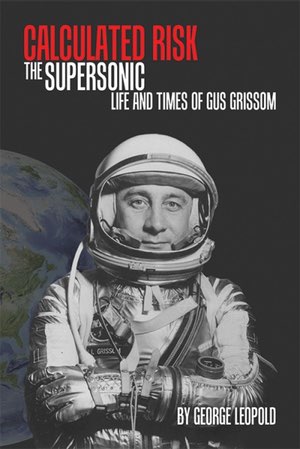Review: Calculated Riskby Jeff Foust
|
| Grissom, like NASA overall at the time, was afflicted with “go fever,” willing to overlook the mounting problems with the Apollo spacecraft. |
The biography Calculated Risk, by George Leopold, is an effort to provide a fuller picture of Grissom’s life, and perhaps also rehabilitate his reputation. The book, Leopold writes in its introduction, is an effort to provide a fuller picture of the life of an astronaut who was “often a footnote” in the early years of the Space Age.
The book, after an introduction that foreshadowed the Apollo 1 accident, follows a conventional chronological approach, following Grissom’s childhood in a small Indiana town and a brief stint in the Army Air Corps at the end of World War II where he neither saw combat nor was trained to fly. Then came studies at Purdue University and joining the Air Force for flight training, combat in the Korean War, and becoming a test pilot.
A central part of the book is Grissom’s flight on Liberty Bell 7, the second Mercury mission, and the aftermath. Grissom was widely criticized then for appearing to blow the hatch prematurely, causing the capsule to sink and nearly costing him his life. That perception continues to this day, thanks in part to Tom Wolfe’s The Right Stuff and what Leopold calls the “cartoonish” film adaption. Leopold argues that there’s no evidence that Grissom accidentally or deliberately activated the plunger that blows the hatch: doing so required significant pressure, and the plunger’s recoil injured the hands of other astronauts who used it. He instead speculates that static electricity when a hook from the recovery helicopter touched the capsule set off the hatch.
Grissom’s recovery from that incident came through Gemini, whose development he supported to the point the spacecraft became nicknamed the “Gus-mobile.” He flew the first Gemini mission in 1965 with John Young, a three-orbit shakedown. That success, ironically, might be one reason he didn’t fly another mission: after serving as a backup on a couple other Gemini missions, Grissom was assigned to support the development of the Apollo spacecraft, earning command of its first mission.
That effort, of course, suffered from many problems. Leopold argues that Grissom knew the spacecraft’s development was troubled, and that flying that first mission would be exceptionally risky. Asked at a pre-flight press conference about his goals for the mission, Grissom said, “As far as we’re concerned, it’s a success if all three of us get back,” a statement at the time interpreted as a joke but which Leopold believes represented Grissom’s “dissatisfaction” with the spacecraft (an anecdote that Leopold mentions multiple times in the book.)
| Grissom took, as the book’s title suggests, calculated risks, but in the end the risks caught up with him. |
If Grissom was so unhappy with the spacecraft, why not do more about it, or even quit the mission? Leopold concludes that Grissom, like NASA overall at the time, was afflicted with “go fever,” willing to overlook the mounting problems with the Apollo spacecraft in order to keep the mission, and the overall effort to land humans on the Moon by the end of the decade, on track. “Grissom and his crew were gambling that the growing list of problems with the spacecraft would somehow be fixed in time for the February launch,” he wrote, a bet that would cost the three-man crew their lives.
While Calculated Risk is clearly an effort to help improve Grissom’s reputation, Leopold does help puncture some of the mythology around his life. After the Apollo 1 accident, Grissom was attributed as the source of a brief but elegant statement: “If we die, we want people to accept it. We’re in a risky business, and we hope that if anything happens to us it will not delay the program. The conquest of space is worth the risk of life.” Leopold finds no firm evidence that Grissom ever said that, and its eloquence would be out of character for a man who, when asked extemporaneously to speak to Atlas rocket workers, simply said, “Well, do good work.”
Another chapter, titled “Extracurricular Activities,” brings up allegations of marital infidelity. It’s not clear how serious they were—he notes “several accounts” that claimed a woman who considered herself Grissom’s girlfriend attended his funeral—but it was clear that his astronaut career, which left him little time at home, was damaging his relationship with his wife Betty. “Had he lived, it’s unlikely their marriage would have survived the strains and temptations of being an astronaut and a public figure,” Leopold concludes, a fate of many other astronaut marriages.
So what’s the message to take away from Calculated Risk? Yes, Grissom was flawed, but who isn’t? He took, as the book’s title suggests, calculated risks, but in the end the risks caught up with him. “But better in the end to have embraced the risk,” Leopold writes, “to know that one had lived, done something worthwhile, to have gone somewhere.” And Grissom indeed did something worthwhile and went somewhere.
